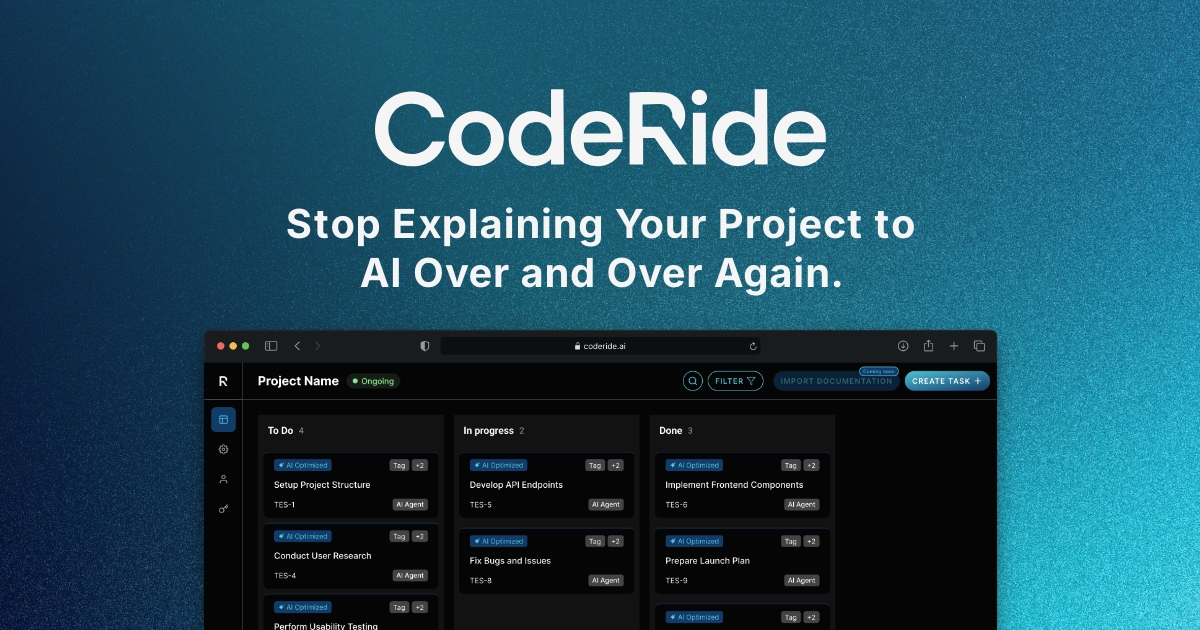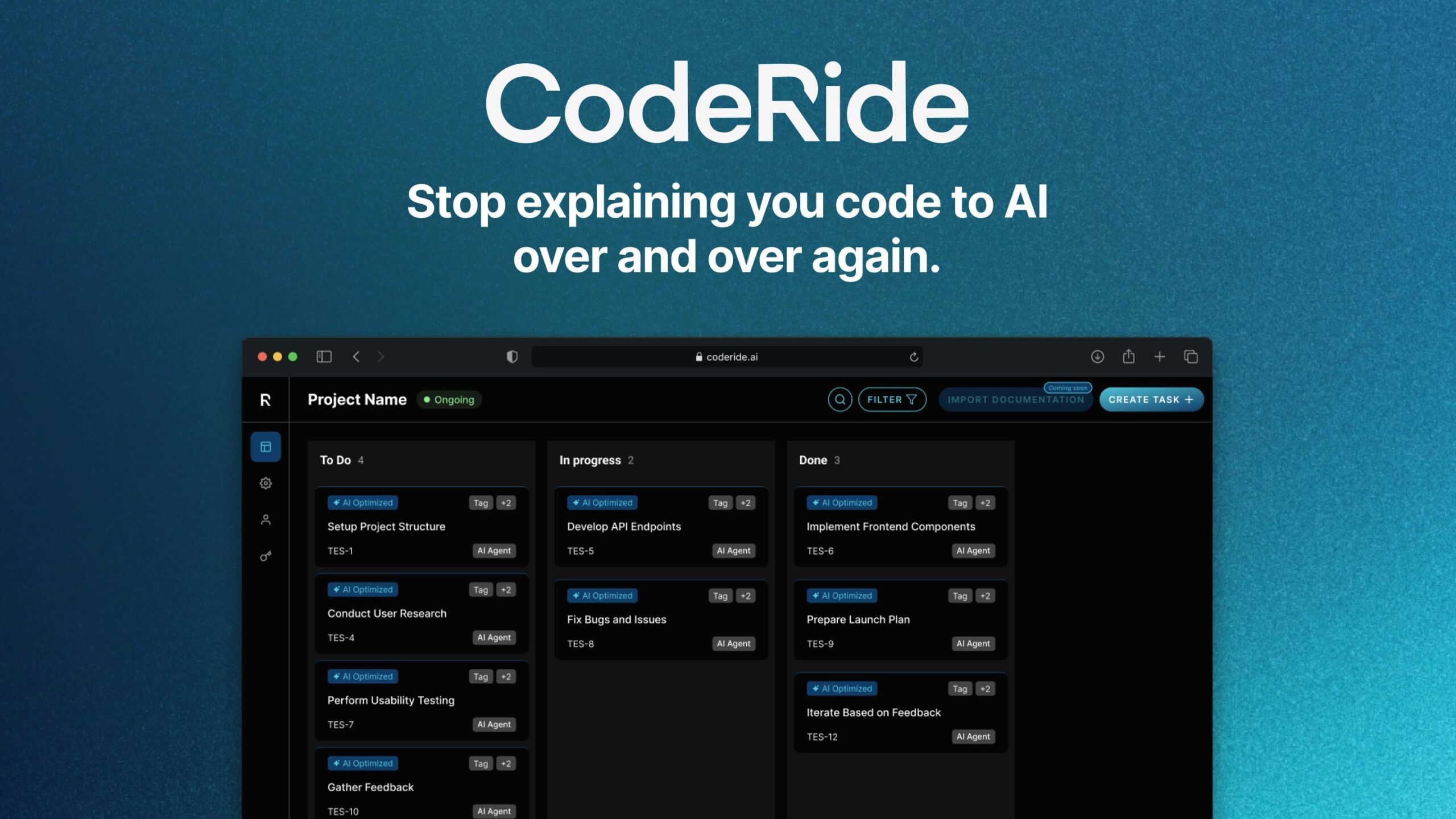
Table of Contents
Overview
In the rapidly evolving landscape of software development, efficiency remains paramount for development teams. CodeRide represents an emerging AI-powered task management solution designed to enhance context retention for AI coding assistants. This beta-stage tool aims to address the common challenge of context loss that developers experience when working with AI coding tools across extended development sessions. By maintaining persistent project context, CodeRide seeks to reduce the repetitive explanations typically required when restarting AI interactions, potentially enabling more seamless task execution and intelligent code generation within existing development workflows.
Key Features
CodeRide offers several features focused on improving AI assistant context management:
- Context-aware task management: CodeRide maintains project context across AI interactions, designed to reduce repetitive explanations during development sessions.
- AI-optimized task instructions: The tool automatically enhances task descriptions with relevant context to improve AI assistant performance.
- Multi-platform compatibility: CodeRide works with various AI coding tools including Cursor, Cline, Windsurf, and GitHub Copilot through Model Context Protocol (MCP) integration.
- Kanban-style task tracking: Provides visual task management with progress tracking as AI agents complete development tasks.
- CSV import functionality: Allows bulk import of existing task lists for project management.
Note: As a beta product, feature availability and performance may vary, and some capabilities may be subject to change or refinement.
How It Works
CodeRide functions as a task management layer that sits between developers and their AI coding assistants. The system stores project context, task histories, and relevant codebase information, then provides this context to AI tools through standardized protocols. When developers interact with supported AI assistants, CodeRide automatically supplies relevant background information, reducing the need to re-establish project context. The tool utilizes the Model Context Protocol to facilitate communication between different AI coding platforms and the CodeRide context database.
Use Cases
CodeRide’s context management approach addresses several common development scenarios:
- Extended development sessions: Maintain project context across multiple AI interactions without manual re-explanation.
- Team collaboration: Provide consistent project context when multiple developers work with AI assistants on shared codebases.
- Complex project management: Track and manage AI-assisted development tasks across larger, multi-component projects.
- Development workflow optimization: Reduce time spent providing context to AI tools, allowing focus on actual development tasks.
- AI assistant efficiency improvement: Enhance AI performance by providing comprehensive project background automatically.
Pros \& Cons
Understanding both the advantages and limitations of CodeRide is essential for informed adoption decisions.
Advantages
- Context persistence: Maintains project context across AI interactions, reducing repetitive explanations.
- Multi-tool compatibility: Works with various popular AI coding assistants through standardized protocols.
- Workflow integration: Designed to integrate with existing development processes without requiring significant changes.
- Task organization: Provides structured task management specifically optimized for AI-assisted development.
Disadvantages
- Beta status limitations: As beta software, users may encounter instability, incomplete features, or unexpected behavior typical of pre-release products.
- Limited track record: Being a newer tool, long-term reliability and performance data are not yet available.
- Security considerations: Like all AI coding tools, CodeRide requires careful evaluation for handling sensitive or proprietary code, particularly given its comprehensive codebase access requirements.
- Dependency risks: Reliance on external AI services and the CodeRide platform introduces potential points of failure in development workflows.
Security and Privacy Considerations
Important additions for enterprise and security-conscious users:
AI coding tools, including CodeRide, present several security considerations that organizations should evaluate:
- Code exposure risks: AI tools typically process code on external servers, potentially exposing proprietary algorithms and business logic.
- Data retention policies: Understanding how long code and project data are stored and whether they’re used for model training purposes.
- Access control: Ensuring appropriate permissions and access controls for sensitive codebases and projects.
- Compliance requirements: Evaluating compatibility with organizational security policies and regulatory requirements.
Organizations should implement appropriate security measures, including code review processes, access controls, and data handling policies when adopting AI coding tools.
Comparison with Established Tools
When evaluating CodeRide against other AI coding solutions, several distinctions emerge:
GitHub Copilot provides comprehensive AI code completion and chat functionality with extensive IDE integration. While Copilot offers some context awareness within individual files and conversations, CodeRide’s focus on persistent project-wide context management represents a different approach to the context limitation challenge.
Cursor delivers an AI-enhanced IDE experience with built-in context understanding and multi-file awareness. Cursor’s strength lies in its integrated development environment approach, while CodeRide functions as a separate context management layer that works across different AI tools.
Tabnine specializes in AI-powered code completion with strong privacy controls and on-premises deployment options. While Tabnine excels at code prediction, it operates differently from CodeRide’s task management and context persistence model.
CodeRide’s distinctive approach focuses specifically on solving the context retention problem across different AI coding tools, rather than providing a complete AI coding solution itself.
Beta Testing Considerations
As a beta product, CodeRide users should be aware of typical beta software characteristics:
- Feature completeness: Some advertised features may be partially implemented or subject to change.
- Stability expectations: Beta software commonly experiences bugs, performance issues, or unexpected behavior.
- Support limitations: Documentation, customer support, and troubleshooting resources may be limited compared to mature products.
- Feedback importance: Beta users play a crucial role in product development through bug reports and feature feedback.
Final Thoughts
CodeRide addresses a genuine challenge in AI-assisted development: maintaining context continuity across extended development sessions. While the tool shows promise in solving context retention issues, potential users should carefully evaluate its beta status, security implications, and fit within their development workflows. The success of CodeRide will likely depend on its ability to deliver consistent context management while maintaining compatibility with the rapidly evolving AI coding tool ecosystem. Developers interested in improving their AI coding workflows should consider CodeRide as part of a broader evaluation of context management solutions, keeping in mind both its innovative approach and current limitations as a beta product.
This analysis is based on publicly available information as of June 2025. Users should verify current features, pricing, and capabilities directly with CodeRide before making adoption decisions.

